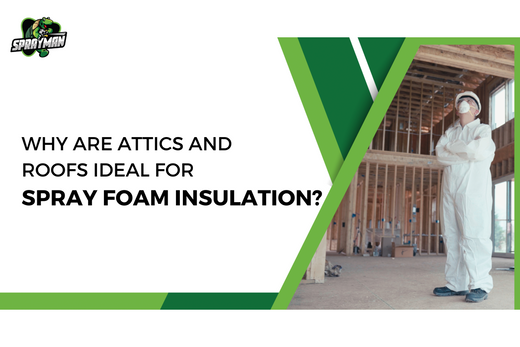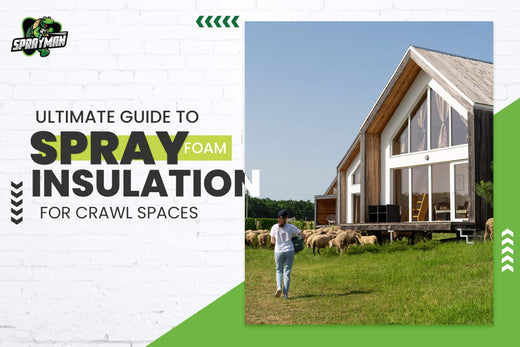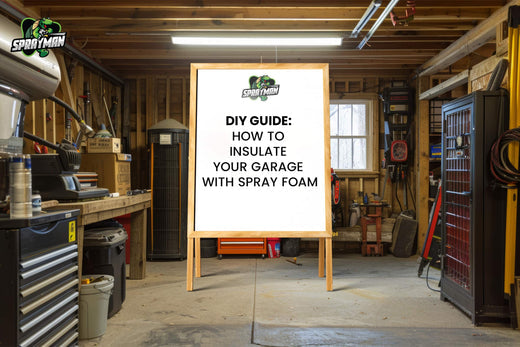Spray foam attic insulation remains one of the most effective solutions available if you’re dealing with rising energy bills or inconsistent temperatures throughout your home. Attics are among the biggest sources of heat loss and air leakage, and using attic insulation foam spray can dramatically improve your home’s thermal performance. By insulating an attic with spray foam, homeowners can create a sealed, energy-efficient envelope that traditional insulation simply cannot match.
Spray foam expands to fill gaps, cracks, and hard-to-reach spaces; preventing up to 40% of energy loss caused by air leakage. Whether you plan to tackle the project yourself or hire a professional installer, spray foam transforms your attic into a far more efficient part of your home. Its ability to deliver high R-values in less space, resist moisture, and form an airtight seal makes it especially effective for attic floors, rafters, and roof decks.
In this guide, you’ll learn everything you need to know about spray foam attic insulation, from choosing the right foam type and understanding the required R-value, to DIY steps and professional installation considerations. We also explain why attics and roof structures benefit uniquely from spray foam’s air-sealing power, and how proper application can significantly reduce energy costs year-round.
By the end of this guide, you’ll understand why more homeowners are choosing spray foam for their attics and how it can deliver long-term comfort, energy savings, and improved home performance.

Do I Need Spray Foam Insulation in My Attics and Roofs?
- It creates a complete air-sealed thermal envelope that traditional insulation cannot achieve
- It prevents up to 40% of energy loss by eliminating air leakage through cracks and gaps
- It delivers superior R-value performance in less space than fiberglass or cellulose
- It protects against both summer heat gain and winter heat loss more effectively
- It significantly reduces monthly energy bills (most homeowners see 30-40% savings)
- It maintains consistent indoor temperatures throughout all seasons
- It provides long-lasting performance without degradation, sagging, or settling
Key Considerations Before Applying Spray Foam in Attics and Roofs
There are several important considerations before applying spray foam in attics and roofs. Some key considerations before applying spray foam attic insulation include;
- Parts of attics to insulate
- Handling old insulation
- The required R-value and thickness for attic insulation
- Choosing the right spray foam product
Which Parts of the Attic Require Insulation?
Spray foam attic insulation is a delicate project, and choosing the required parts depends on your goal. The two major areas to insulate are the attic floor and rafters. The key factor in deciding which parts to insulate is whether you plan to use the attic as a living space.
Attic Floor Insulation: If you do not intend to use the attic as a living space, insulate the attic floor. Spray foam attic floor prevents excess heat transfer from the attic to other parts of the building.
Attic Rafter Insulation: If your attic will be part of your living space or a common area, insulate the attic rafters. Spray foam rafters helps maintain a comfortable living temperature in the attic by preventing heat transfer at the roof level.
Important Note: Do not insulate the attic floor if you are using your attic as a living space and have already insulated the exterior of your home, including the attic. This creates an isolated climate and is not recommended.

How to Handle Old Insulation in Your Existing Home?
Before applying new spray foam attic insulation, it is essential to remove any existing insulation. Old insulation blocks air circulation and promotes mold growth in your home. When air circulation is restricted in buildings, the HVAC system works harder to maintain a consistent temperature. You can learn how to remove spray foam insulation or hire a professional contractor.
The Required R-Value and Thickness for Attics and Roofs
Spray foam insulation thickness determines its level of thermal resistance. Thick spray foam typically means a higher R-value. Thus, closed-cell spray foam insulation R-value offers better thermal insulation. The required thickness when using closed-cell spray foam attic is 4-5 inches, and 6-10 inches for open-cell spray foam insulation.
The required R-value for your attic depends on your location (climate zone). Spray foam insulation r-value for attics and roofs for climate zone 1 is R39 - R40. Also, if you are in zone 3, the required R-value for attic insulation is R49 - R 60. To know the right thickness and R-value for your attic, refer to our detailed article, "Understanding the Importance of R-Value in Spray Foam Insulation."
Choosing the Right Spray Foam Insulation Product
The two types of spray foam insulation offer excellent thermal insulation capabilities for attics and roofs. Open-cell spray foam insulation is light and water-permeable and provides a lower R-value than closed-cell spray foam. On the other hand, closed-cell spray foam insulation is preferred over open-cell because it is dense and moisture-resistant. Closed-cell spray foam is expensive, but it is most effective for air-sealing attics and roofs. Discover the complete comparison of open vs. closed-cell spray foam insulation.
Step-By-Step Guide To DIY Spray Foam Insulation In Attics And Roofs
It is important to understand that DIY attic spray foam insulation requires proper planning and attention to detail. In this section, we will highlight a step-by-step guide on how to install spray foam insulation;
Step 1: Get All The Necessary Materials Needed
The first step is to get all the necessary materials, most importantly spray foam insulation kits and protective gear. Other materials needed for DIY insulation are a spray foam gun, utility knife, plastic sheeting, and measuring tape.
Step 2: Wear Protective Equipment
Safety is important when applying spray foam insulation. Wear all the necessary protective gear, such as gloves, respirators, and goggles.
Step 3: Prepare The Area
Measure the attic and roof using a measuring tape to determine the amount of spray foam needed. Then, use the Sprayman Spray Foam Insulation Calculator to determine the number of spray foam cans needed for the job.
Then, prepare the attic by removing debris or water leaks. Use a sealant to seal large holes or gaps that cause air filtration. Always remove any existing insulation. Ensure proper ventilation before you begin insulation.
Step 4: Set Up The Spray Foam Product
Set up the spray foam product by vigorously shaking it. Then, load the product into a spraying gun for easy application.
Step 5: Apply Spray Foam
Apply spray foam starting from the farthest point to the attic access. The best method is to apply it in layers. Allow each layer of spray foam to expand and cure before applying a new one. Apply spray foam in a steady and consistent motion while holding the spraying gun 12 - 18 inches from the surface. Cover all the spots and tight spaces in the attic. Ensure you apply spray foam in moderation as it expands.
Step 6: Allow It To Dry
Allow the foam to dry for at least 24 hours after application. Proper curing ensures spray foam is durable and efficient for a long period.
Step 7: Smoothen The Foam
Use the utility knife to remove excess foam to achieve a smooth finish. Smoothing the foam after application makes adding finishing touches, such as painting, easy.
Step 8: Inspect Work
Check for any missed spots and attend to them immediately. In addition, check for any air leaks or restricted ventilation in the attic.
Maintaining Your Spray Foam Insulation In Attics And Roofs
Regular spray foam attic insulation maintenance ensures its effectiveness over time. It is one way to enjoy the long-term effects of spray foam insulation.
Here are 5 ways to maintain your spray foam insulation in attics and roofs:
- Clean the attic and roofs regularly.
- Repair water leaks immediately
- Ensure proper ventilation in the attic
- Address mold and mildew growth
- Hire a professional for routine check
Benefits of Sprayman Spray Foam Insulation For Contractors
Spray foam insulation contractors choose the best spray foam products to improve their work quality and client satisfaction. The best spray foam insulation on the market is Spraycoat Fire Rated Insulation Spray Foam. It is affordable, efficient, and easy to use. It serves a dual purpose by providing a barrier against building noise and heat transfer. Some of the advantages of spray foam insulation as a result of using Sprayman include:
Elimination of Lingering Odor
Different spray foam products have caused many cases of lingering odor in buildings. Fixing these problems causes loss and additional no-pay work for contractors. Sprayman Product solves this problem quickly. Sprayman spray foam product does not give a foul after application. It is properly formulated and does not undergo off-gassing after curing.
Cost-Effective Solutions for Contractors
Professional contractors also suffer from the expensive cost of materials. The high price of spray foam kits makes it difficult for contractors to profit from insulation jobs. As Sprayman products are affordable 'spray foam in a can' and easy to use, they do not require expensive, maintenance-heavy machines like traditional spray foam insulation machines. The ease of setup and use also allows contractors to save time and increase their earnings.
Versatility
Sprayman spray foam is suitable for application on different surfaces. They can be applied on uneven and smooth surfaces. They also offer superior bonding strength.
Eco-friendly
Sprayman spray foam is formulated with low GWP materials and is environmentally friendly. They help reduce the overall carbon footprint in buildings. Contractors do not have to worry about air contamination when using Sprayman Spray foam.
Customer Satisfaction
Using Sprayman Spray foam products ensures a quality insulation job. They offer superior thermal insulation that leads to significant energy efficiency in buildings. A good insulation job helps to build client trust and improve the contractor’s reputation.

Understanding The Costs Of Spray Foam Insulation For Attics And Roofs
The average cost to spray foam attic is $1.5 - $5 per square foot. The cost of attic spray foam insulation for a 1,000sq ft with closed-cell is $6,900 - $10,000+. The spray foam insulation cost for attics and roofs is dependent on several factors, including the type of foam insulation, location, thickness, and size of the project. DIY spray foam insulation is one way to insulate your attics and roof without breaking the bank. It saves the cost of hiring a professional contractor.
Eco-Friendly Benefits Of Using Spray Foam In Attics And Roofs
Attic spray foam insulation lowers carbon footprints in homes by reducing energy consumption. Insulating attic rafters and roofs helps to condition the space, creating an extra living space that can be used as a study, home office, or extra room. The benefits of spray foam insulation pay for itself in the long run. Attic spray foam insulation is a wise investment that goes a long way to improve the living conditions in your home.
Troubleshooting Common Issues With Spray Foam In Attics And Roofs
Despite the advantages of spray foam insulation in attics, it is not all roses. There are spray foam attic insulation problems that are common in many homes. Here are some common issues associated with spray foam attic insulation and their solutions;
Lingering Odor After Application
Many homeowners complain about the smell of spray foam insulation. Spray foam insulation creates an air seal in attics and roofs, making it difficult for foul odors in the room to disappear when there is no proper ventilation. To solve the lingering odor problem in attics and roofs, contractors install attic ventilation with spray foam. Using high-quality spray foam products also solves this problem.
Mold Problems
Spray foam insulation mold problems are a common occurrence caused by improper installation. It is a problem shared with closed-cell spray foam insulation. Mold problems occur in attics when moisture issues, such as water leaks, are neglected before installing spray foam. The best way to avoid this problem is to fix all water issues before installing spray foam insulation.
Cost
Without a doubt, the cost of attic spray foam insulation is expensive. The cost of installation is heavy on the homeowner and contractor. The contractors' cost of materials is high, and they need to make profits after deducting expenses. Affordable spray foam insulation kits are used to save costs.
FAQs
Is Spray Foam Insulation Good For Attic?
Spray foam insulation is the best insulating material for attic floors and roofs. It provides superior thermal, sound, and water barriers. In addition, it keeps your home conditioned all year and significantly reduces energy consumption.
Is Spray Foam Better Than Blown In Attic?
Yes, spray foam insulation offers better thermal insulation than blown-in insulation. Regarding thermal resistance, spray foam insulation has a higher R-value than blown-in insulation.
What Is The Best Insulation For Attic?
The best insulation for the attic is closed-cell spray foam insulation. It has a high R-value, water resistance, and excellent thermal resistance. Spray foam reduces heat transfer from the attic to other building parts. In addition, spray foam insulation saves up to 40% on energy bills in a building.
What Are The Differences Between Ceiling And Roof Insulation?
Roof insulation is applied to the underside of the roof deck, while ceiling insulation is used in the attic. Roof insulation envelops the entire building structure, while ceiling insulation is installed to condition the living space below it.
Can I Use Spray Foam Insulation Under A Metal Roof?
Yes, metal roof insulation is installed using spray foam. Spray foam insulation provides an airtight seal and soundproofing capabilities.
Which Surface Materials Are Suitable For Spray Foam Insulation?
Common building materials such as wood, metal, masonry, and stones are surfaces suitable for spray foam insulation. These materials are also referred to as substrates.
How Can I Add Spray Foam Insulation To An Existing Attic?
Spray foam insulation can be added to an existing attic by following the step-by-step guide above. First, get the necessary materials. Then, prepare the area for insulation by removing water leaks, debris, etc. Third, apply the foam insulation and allow it to dry.
How Long Does Spray Foam Insulation Off-Gas?
Off-gassing releases Volatile Organic Compounds (VOCs) into the atmosphere. Spray foam insulation off-gassing begins 24 - 48 hours after application.
Does Attic Spray Foam Need To Be Vented?
Venting attics is essential when installing spray foam insulation. Vents help improve airflow, reduce heat build-up, and eliminate moisture problems in attics. They are mostly preferred in areas with high humidity rather than cold climates.
Can Spray Foam Insulation Get Wet?
Closed-cell spray foam insulation offers excellent resistance to moisture, which means it can get wet without damage. Nevertheless, prolonged exposure to water destroys the insulation's efficiency.




Leave a comment
This site is protected by hCaptcha and the hCaptcha Privacy Policy and Terms of Service apply.